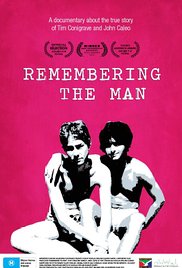
REMEMBERING THE MAN
Australia, 2015, 86 minutes, Colour.
Directed by Nickolas Bird, Eleanor Sharpe.
The title of this documentary is a variation on Holding the Man, the memoir written by Tim Conigrave, published posthumously in 1995, about his relationship with John Caleo from their time at Xavier College in 1976 to John Caleo’s death from AIDS in 1992. Tim Conigrave himself died from AIDS in 1994. His memoir was soon adapted for the stage and, in 2015, the film version, directed by Neil Armfield was released to critical acclaim.
The emphasis in the first half of the film is on the relationship between the two boys at school, its development over the years, the change in relationship of each boy in his early 20s, and their initial careers. While this story continues, in the second half of the film the focus shifts to the AIDS epidemic. In fact, at the end of the film, there is a statement that Holding the Man is a key contribution to the history of the pandemic in the 1980s and into the early 1990s.
Those who have read the book, or seen the play, or seen the film, we will be familiar with most of the events which are portrayed here. Of course, the Holding the Man screenplay amplified many of the events noted here – but this film gives far more attention to the acting career of Tim Conigrave and his play and its performance, Soft Targets.
The film makers have been able to assemble a great number of photographs of the two boys, of the two men, as well as quite some video footage. They are incorporated into the narrative of this film. When photographs or video material is not available, some actors portray the two men, their parents, and some others associated with them in dramatic portrayals.
As with most documentaries, there are many interviews and talking heads, from school friends from Xavier days, both men and women, from friends who shared houses with them, with many who studied at NIDA with Tim Conigrave, and the number of men and women who were involved in social work and hospital care. The impression that they all give is that John Caleo was a quiet young man, a talented sportsman, and effective chiropractor, the more stable of the two, while Tim Conigrave was quite flamboyant from his earliest years, something which developed in his theatrical interests, his theatrical training and performances.
One of the values of this film is that there are considerable excerpts from three audiotapes of interviews which Tim Conigrave made in 1993 for a National Library project of witnesses to the experience in Australia of AIDS. It is interesting to listen to the tone of voice, generally quite sober, and, Conig recollections – much more serious than many of the photos and video excerpts that are shown. He was only a year or so away from his own death.
There is a lot of historical footage from the 1970s, especially with public opinion against homosexuals, scenes from Gay Mardi Gras as well as scenes of protest, especially some led by the Rev Fred Nile, quotations from the book of Leviticus, and other denunciations and, in more secular sequences, for example from Australian television in 1976, Monday Conference, a great deal of poofter-bashing. This gives the context of the relationship – something which has changed fairly extensively in the subsequent 40 years.
Tim Conigrave is supportive in his opinions of the Jesuits who ran Xavier College, a re-enacted scene with a priest at a holiday house and finding the two young men together and leaving them be. The understanding of the Jesuits is named explicitly Conigrave.
As regards the funeral Mass for John Caleo Kelly (somewhat contentious in Holding The Man), at which Father Peter Wood MSC, the AIDS Chaplain in Melbourne at the time, presided (who is credited as one of those interviewed for the film), it is mentioned that there were six priests present – although, as in the movie, but much more explicit here which does explain the funeral sequences in the movie, John Caleo’s father was quite clear to Tim Conigrave that there was to be no mention of homosexuality or AIDS and that Tim Conigrave was not to sit with the family. There is a very disappointing priest postscript when one of the friends explains how Tim Conigrave had asked these friends to light candles for him in the church (St Patrick’s Cathedral), but a priest tells them to go away and is seen locking the iron gates against them and walking away. However , there is religious feeling as the camera goes inside a church, a Catholic Church, and tracks up to the altar where there is a photo of the two men (and a Mickey Mouse doll which Tim Conigrave used as a symbol of himself).
Some of the images in Fairfield Hospital and St Vincent’s Hospital of AIDS sufferers are quite graphic and bring home to audiences just how surprising, shocking and disturbing this new epidemic was and the toll that it took on those who were positive and who died of AIDS .
A significant film for going back into Australian gay history as well as the Australian experience of the beginning of AIDS and the development in the 1980s and 1990s.